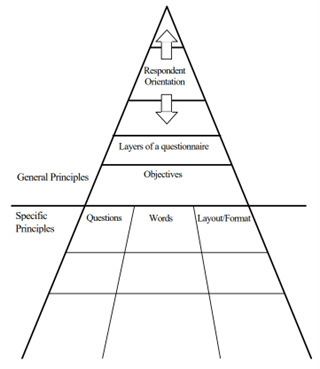
Introduction
Carrying out Employee Satisfaction Surveys has many benefits including the ability to measure the level of engagement and satisfaction of staff, to identify areas of strengths and best practices, as well as potential risks and opportunities for improvement, and to provide input for managers for performance improvement. Besides, the survey can also serve to inform organizations of training and development as well as career development needs of staff. When carried out consistently, results from Employee Satisfaction Surveys can serve as a benchmark for future progress tracking.
Survey Design
Questionnaire Design Framework
In developing the survey questionnaire, reference can be made to Labaw’s Framework for Questionnaire Design (Labaw (1980) as cited in Gendall (1998)). Labaw’s framework is divided into three main layers relating to question design, question wording, and formatting or layout. All three layers should be looked at and considered holistically during the survey design process.
The general principles presented by Labaw (1980) states that survey design is very much driven by the respondent’s orientation and defines the type of questions we can ask, words we can use, concepts we can explore, and the methodology we can use. It is important to craft questions by considering what the respondents can answer truthfully and to be careful not to impose our own values, perceptions, and language on the respondents.
Labaw (1980) also emphasized the importance of first determining the goals or objectives of the survey before beginning to think about questions and wordings.

Survey Development Process
Applying Labaw’s framework, start by first defining the objective of the survey by determining areas that needs to be measured. This might include areas like staff engagement, leadership, and staff development. It is alright if the categories do not emerge all at once at the beginning. More categories will emerge as you go through an iterative process during the question development phase.
Likert Scale
One method to consider for respondents to provide their answers is using the Likert Scale which offers a method for measuring attitude, opinion, or perception using a scale (Salkind, 2010). This method involves asking respondents to react to a statement stem of fact or opinion. Respondents then record their responses on a 5-point scale as follows:
1 – Strongly disagree
2 – Disagree
3 – Neither agree nor disagree
4 – Agree
5 -Strongly agree
Statement Stem Development
After settling on using the Likert Scale and the initial areas to be measured, begin crafting the statement stems. As the statements emerge, certain categories may feel like they have too many statements and can be broken down further or grouped into separate categories of their own. Also consider adding some open-ended questions to allow for capturing feedback that were not covered in the scope of the statement stems.
Refinement
Referring to Labaw’s Framework, go through each statement stem to weigh in on the wordings used to consider if the respondents can answer them truthfully. Also make sure that the stems are crafted in a way that did not impose values, perceptions, and language on the respondents. Rephrase questions as necessary.
Consistency is key in the statement stem development process. It is much easier for both the respondents as well as for the final data analysis if the question stems are phrased as either positive or negative throughout. Using a mixture of positive and negative statements may confuse respondents and stall their progress in answering the survey.
Instruments and Survey Questions
When developing the statement stems, look through established survey instruments for tried and tested questions that have been proven to work better in measuring employee satisfaction.
Survey Deployment
Survey Deployment Method
Once the survey questions and design have been completed, consider different methods for deploying the survey. There is the option of handing out hardcopy survey questionnaires or conducting the survey digitally using a tool like Google Forms or Survey Monkey.
Using a digital tool like Google Forms offers an automated way to collect data and respondents could type instead of write down their answers on paper. Google Forms also allows for a higher level of anonymity versus handwriting which can easily be recognized if the intention is for respondents to remain anonymous. Besides, all responses submitted via Google Forms are automatically stored and tabulated in a Google Sheet for ease of data analysis later.
Survey Options
After settling upon a survey deployment method, you will need to lay down the rules and settings that control the survey. The considerations include the following:
- Privacy conditions – whether to allow respondents to remain anonymous or not
- Survey period – how long the survey be made available to respondents to answer
- Survey access – how will respondents access the survey (eg. via a link emailed to their company email address)
- Survey submission – rules governing multiple submissions and ability to edit responses after submission.
Survey Instruments
Apart from the actual survey, it is also important to communicate the initiative to the team prior to the survey deployment. It is highly recommended that an announcement be made to the team beforehand to alert them about the upcoming survey exercise and explain the purpose and objectives of the survey.
An email invitation along with a cover letter explaining the objectives of the survey can follow next to invite respondents to complete the survey. The invitation may also include details like method of completion, survey due date, and how the survey results will be used.
Data Analysis & Recommendations
Once the submission period is over, consolidate all raw data and begin by sorting and categorizing the data. Next, create a framework for capturing the minimum, maximum, and average (mean) score for each statement. Besides these, also consider calculating the standard deviation and percentage scores for every single statement stem to derive more insight on the weight of the responses.
After thorough analysis has been applied to the data, proceed to make recommendations based on the analysis and feedback received from employees.
References
- Gendall, P. (1998). A framework for questionnaire design : Labaw revisited. Marketing bulletin, (9), pp.28–39.
- Salkind, N. J. (2010). Encyclopedia of Research Design. SAGE.

